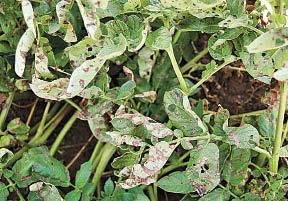

Fungicides containing chlorothalonil, copper hydroxide or mancozeb are recommended and should be available at local lawn and garden centers.įor further information please contact your local Extension office at 31 or stop by at 702 Madeline St. N Roundworm Nematode Meloidogyne arenaria, M.

However, treatment is not often required. MT0-30 Indicates seeds have been tested for Lettuce Mosaic Virus, and that none was found in a sample of 30,000 seeds or more. Early blight is a fungus that, looks like late blight, can defoliate and even destroy unprotected potato crops. Late blight spots, caused by the fungus Phytopthora infestans, start out pale green, usually near the edges of tips of foliage, and turn brown to purplish black (Fig. Do not confuse early blight with two other diseases, late blight and Septoria leaf spot. Early Blight is a fungal disease most known for infecting plants in the Solanaceae family, like tomatoes and potatoes, although it can infect other plant. Fungicides will only protect the plant tissue that has been sprayed but should be reapplied every seven to 10 days to provide adequate protection. MT0-10 Indicates seeds have been tested for Lettuce Mosaic Virus, and that none was found in a sample of 10,000 seeds or more. Early blight and closely related diseases. Increasing distance between plants to improve airflow and promote drying will help.įungicides should be used as soon as symptoms appear. Cultural practices include use of clean seed, crop rotation and complete removal of plants at the end of the growing season. Very few early blight resistant tomato varieties are available, so management of the disease relies primarily on cultural practices and the use of fungicides. Irrigating tomatoes can create these conditions. Early blight is common in tomato gardens. Your best option is to apply some Integrated Pest Management principles to limit the fungus’ spread and survival. It spreads over a wide range of temperatures when conditions are wet and humid. Early blight is a fungal disease, and for the home gardener, mass application of fungicides is not practical or advised. The pathogen produced in debris spread to the new crop by wind or splashing water. Fruit lesions appear as sunken, dark-colored sunken spots with concentric rings within them.Įarly blight survives primarily in infested debris from the previous tomato crop but may also survive on contaminated seeds. Symptoms on stems are oval and elongated, brown and sunken lesions with rings within them. Left untreated, it causes leaf defoliation which exposes stems and fruit to potential damage. As the lesions expand, concentric rings or ridges become evident within them. Initial symptoms are small, dark-colored, circular lesions, often surrounded by chlorotic (yellow) tissue. This disease first develops on the older leaves lower on the plant then progresses up the plant, especially during fruit production. The pathogen can cause disease on leaves, stems and fruit but is more damaging on the leaves where it causes lesions and premature defoliation. This news article appeared in the Delhi Dispatch.Įarly blight is one of the most common diseases of tomatoes in Louisiana. Keith Collins is the LSU AgCenter county agent for Richland Parish.


 0 kommentar(er)
0 kommentar(er)
